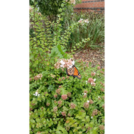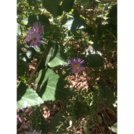
A teacher’s guide from the 2022 Treaty Education Summer Institute which uses storytelling as a portal to explore Treaties.
- Subject:
- Arts and Humanities
- History
- Social Science
- World Cultures
- Material Type:
- Activity/Lab
- Lesson
- Date Added:
- 10/09/2024

A teacher’s guide from the 2022 Treaty Education Summer Institute which uses storytelling as a portal to explore Treaties.

The First Peoples of Canada recognize certain members of their communities for their ability as storytellers. The skillful art of storytelling is passed down from one generation to another by chosen, recognized or hereditary storytellers.
Some stories are shared at certain times of the year, in designated areas and on special occasions. As well, parents, family members and Elders share their knowledge with the younger generations in the course of their daily activities.
The stories we want to share with you here are from the Inuvialuit, the Algonquin, the Métis and Cree, the Nisga'a, the Abenaki and the Mi'kmaq. They are told through movement, song and dance, using symbols and imagination. They teach us about the origin of sacred objects and ceremonies, and our relationship to the animals, plants, rocks and each other.

Working as engineering teams, students design and create model beam bridges using plastic drinking straws and tape as their construction materials. Their goal is to build the strongest bridge with a truss pattern of their own design, while meeting the design criteria and constraints. They experiment with different geometric shapes and determine how shapes affect the strength of materials. Let the competition begin!

Students work together in small groups, while competing with other teams, to explore the engineering design process through a tower building challenge. They are given a set of design constraints and then conduct online research to learn basic tower-building concepts. During a two-day process and using only tape and plastic drinking straws, teams design and build the strongest possible structure. They refine their designs, incorporating information learned from testing and competing teams, to create stronger straw towers using fewer resources (fewer straws). They calculate strength-to-weight ratios to determine the winning design.

Students culture cells in order to find out which type of surfactant (in this case, soap) is best at removing bacteria. Groups culture cells from unwashed hands and add regular bar soap, regular liquid soap, anti-bacterial soap, dishwasher soap, and hand sanitizer to the cultures. The cultures are allowed to grow for two days and then the students assess which type of soap design did the best job of removing bacteria cells from unwashed hands. Students extend their knowledge of engineering and surfactants for different environmental applications.

En esta lección desarrollarás tu fluidez matemática, al sumar datos sobre insectos, recolectados al aire libre. Esta actividad fue creada por Out Teach (out-teach.org), una organización sin fines de lucro que proporciona aprendizaje experiencial al aire libre, con el objetivo de transformar la educación de las ciencias para los estudiantes en comunidades más desatendidas.

STUDENT ACTIVITY - 2nd Grade: This is a distance-learning lesson students can complete at home.Students will conduct a simple experiment to see if plants need sunlight and water to grow.This activity was created by Out Teach (out-teach.org), a nonprofit providing outdoor experiential learning to transform Science education for students in under-served communities.

Explorarás al aire libre en busca de evidencia de la vida animal e imaginando qué tipos de animales podrían vivir y sobrevivir en esa área.Esta actividad fue creada por Out Teach (out-teach.org), una organización sin fines de lucro que proporciona aprendizaje experiencial al aire libre, con el objetivo de transformar la educación de las ciencias para los estudiantes en comunidades más desatendidas.

This activity demonstrates how potential energy (PE) can be converted to kinetic energy (KE) and back again. Given a pendulum height, students calculate and predict how fast the pendulum will swing by understanding conservation of energy and using the equations for PE and KE. The equations are justified as students experimentally measure the speed of the pendulum and compare theory with reality.

This activity shows students the engineering importance of understanding the laws of mechanical energy. More specifically, it demonstrates how potential energy can be converted to kinetic energy and back again. Given a pendulum height, students calculate and predict how fast the pendulum will swing by using the equations for potential and kinetic energy. The equations will be justified as students experimentally measure the speed of the pendulum and compare theory with reality.

Students conduct an experiment to determine whether or not the sense of smell is important to being able to recognize foods by taste. They do this by attempting to identify several different foods that have similar textures. For some of the attempts, students hold their noses and close their eyes, while for others they only close their eyes. After they have conducted the experiment, they create bar graphs showing the number of correct and incorrect identifications for the two different experimental conditions tested.


This is an overview

test

Test overview

This is an overview

Through Mala's Eyes takes a look at the Inuit community and helps students understand and appreciate one of the diverse cultures that exist within Canada. This resource looks at the life of an Inuit community in northern Quebec, through the eyes of Mala, a twelve year old Inuk boy. Through his first person narratives, Mala provides interesting background information about life in his community.
Downloadable teaching resource provided.
This is an excellent resource for teaching students about Inuit life. This resource speaks directly to students as it is given from the point of view of a twelve year old child. Students ages nine to fourteen should enjoy relating to these stories. It is rare to find a resource about Inuit life that is this modern, positive and engaging.
There are a variety of activities included within the resource, and teachers are encouraged to choose those which best apply to their classroom. There is also a lot of good background information provided in the resource, such as a glossary of Inuit terms and the Inuit alphabet. As well, online links are provided for more information.

Los estudiantes aprenden acerca de la biomímisis y el proceso de diseño técnico al diseñar y construir un modelo del pie de la perdiz.

Explorarás al aire libre tratando de encontrar ejemplos de diferentes tipos de energía, incluyendo mecánica, eléctrica, térmica, sonora y luminosa. Esta actividad fue creada por Out Teach (out-teach.org), una organización sin fines de lucro que proporciona aprendizaje experiencial al aire libre, con el objetivo de transformar la educación de las ciencias para los estudiantes en comunidades más desatendidas.

Towers have been a part of developed society for centuries, serving a variety of purposes, from watch towers to modern cell towers. In this activity, student groups design and build three types of towers (guyed or cable-supported, free-standing or self-standing, and monopole), engineering them to meet the requirements that they hold an egg one foot high for 15 seconds.